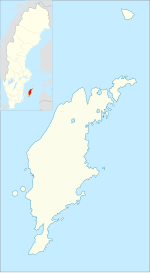Grötlingbo church
| Grötlingbo Church | |
|---|---|
| Grötlingbo kyrka | |

Grötlingbo Church, external view
|
|
| 57°08′01″N 18°20′48″E / 57.1335°N 18.3466°ECoordinates: 57°08′01″N 18°20′48″E / 57.1335°N 18.3466°E | |
| Country | Sweden |
| Denomination | Church of Sweden |
| Administration | |
| Diocese | Visby |
Grötlingbo Church (Swedish: Grötlingbo kyrka) is a medieval Lutheran church in Grötlingbo on the island of Gotland, in the Diocese of Visby (Sweden).
The earliest written record of the church is from 1296, when it is mentioned in a papal bull. Archaeological excavations carried out in 1956–1957 however show that there was a stone church here already in the 12th century. The finely carved reliefs that adorn the southern façade of the present church obviously come from this first, Romanesque church and have been incorporated in the later Gothic church that is visible today. The western tower was added in the 13th century, and a major reconstruction of the church into its present form was carried out during the late 14th century. The church has remained largely unaltered since, except for a few new furnishings.
Asger Jorn is buried in the church cemetery.
The church is rather large for a country church on Gotland, and built of local sandstone. The nave is divided in three sections by sturdy columns. The choir lacks an apse and instead ends with three slender Gothic windows, a treatment typical for medieval churches on Gotland. The tower is Romanesque but the spire dates from the 18th century.
The southern church façade is adorned with Romanesque friezes, made by the artist commonly referred to as Sigraf and dating from circa 1200. They depict animals, both real and mystical, as well as fighting men and knights on horseback. Scholars are divided as to what they may depict. Some speculate that they may be an illustration of evil forces, pursuing humans. Others argue that they may be illustrating an ancient tale, perhaps that of Beowulf.
...
Wikipedia

